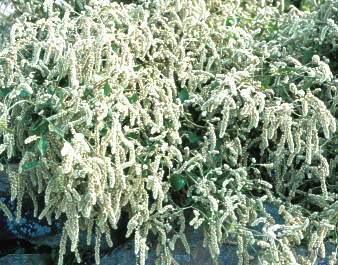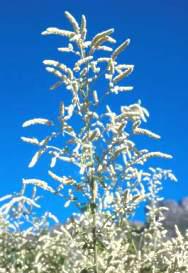Aerva leucura
Aerva leucura Moq.
Family: Amaranthaceae
Common names: aambeibossie
Introduction
It is not the size of the flowers, but rather the reliable show Aerva leucura gives in the herbaceous border from summer to autumn, that makes this a worthwhile plant for the garden. From each plant tall, graceful stems shoot from the ground in spring and grow to almost 1 metre.

Description
Description
The attractive, creamy spikes are formed on thin side branches off the main stems. Fascinating and strange, the flowering spikes hang like little woolly worms from the stems. The creamy spikes are densely packed with the new buds and old flowers of which only the woolly bracts and perianth (calyx and corolla collectively) are seen. When looking very closely one can see the tiny, green flowers that open randomly and only a few at a time. The egg-shaped leaves with their wavy edge are sparsely arranged along the stems. The dull green leaves turn yellow or red in autumn. The stems and leaves are covered in tiny white hairs.

Distribution and habitat
Distribution description
Aerva leucura is widespread in the summer rainfall regions of South Africa, Namibia and Botswana.
Derivation of name and historical aspects
History
About 10 species of Aerva are found in the warmer parts of Africa and Asia with three species occurring in Southern Africa.
Uses
Use
In Watt & Breyer-Brandwijk's book Medicinal and Poisonous Plants of Southern and Eastern Africa they mention that the dry flowers of Aerva leucura were used to stuff pillows in Bechuanaland. Betsie Rood mentions in her book "Uit die veldapteek" that roots of Aerva leucura were used medicinally for treating piles and as a blood purifier.
Growing Aerva leucura
Grow
In the garden Aerva leucura has the potential to be used far more for landscaping. The dense flowering spikes create an interesting texture for contrast, while the soft, creamy colour is easy to blend with other colours. Plants flower from summer to autumn (November- April). Aerva leucura goes dormant during the cold winter months and the plants are cut down to the ground. Fresh, new growth starts to shoot again in spring. New plants take about a year to establish and then get more vigorous and tough with age.
At Kirstenbosch Aerva leucura has been very successful in the herbaceous planting with the wild forget- me- not (Anchusa capensis), the ribbon bush (Hypoestes aristata) and Vernonia glabra which also flowers till late autumn. Aerva leucura requires full sun and water during the summer when it is actively growing. It will do best in a well drained, loamy soil.

Aerva leucura is propagated from cuttings of the new shoots in spring and early summer. The cuttings root fast and usually within 3 months the young plants are ready to be planted into the garden.
References
- Leistner, O.A. (ed.). 2000. Seed plants of southern Africa: families and genera. Strelitzia 10. National Botanical Institute, Pretoria.
- Rood, B. 1994. Uit die veldapteek
- Van wyk,B, Malan, S. 1988 Field guide to wildflowers of the Witswatersrand and Pretoria
- Watt, J.M. & Breyer-Brandwijk, M.G. 1962. The medicinal andpoisonousplants of southern and eastern Africa , edn 2. Livingstone, Edinburgh & London.
Credits
Liesl van der Walt
Kirstenbosch
April 2001
Plant Attributes:
Plant Type: Perennial
SA Distribution: Eastern Cape, Free State, Gauteng, KwaZulu-Natal, Limpopo, Mpumalanga, North West, Northern Cape
Soil type: Sandy, Clay, Loam
Flowering season: Early Summer, Late Summer, Autumn
PH: Neutral
Flower colour: White, Cream
Aspect: Full Sun
Gardening skill: Easy
Special Features:
Horticultural zones











Rate this article
Article well written and informative
Rate this plant
Is this an interesting plant?
Login to add your Comment
Back to topNot registered yet? Click here to register.